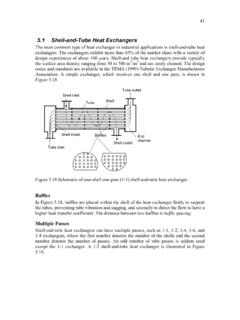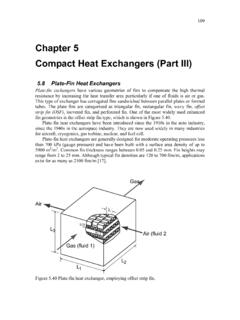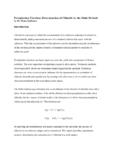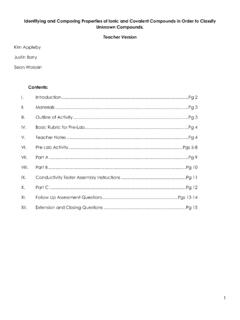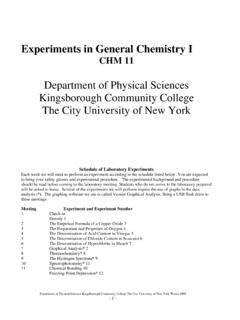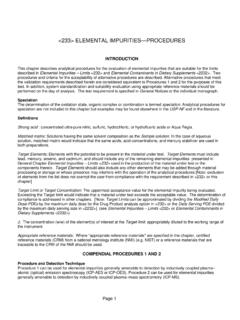Transcription of SOLUBILITY, IONIC STRENGTH AND ACTIVITY COEFFICIENTS ...
1 Physical Chemistry Laboratory Experiment II-6b solubility , IONIC STRENGTH AND ACTIVITY COEFFICIENTS . References: 1. See `References to Experiments' for text references. 2. W. C. Wise and C. W. Davies, J. Chem. Soc., 273 (1938), "The Conductivity of Calcium Iodate and its solubility in Salt Solutions". Background: Study the references to the text and the section on "Theory and Discussion" carefully. Know the definitions of the following and their interrelations: ACTIVITY a, ion ACTIVITY , ai, mean IONIC ACTIVITY , a . ACTIVITY coefficient, , ion ACTIVITY coefficient, i, mean IONIC ACTIVITY coefficient, . solubility , S in moles per liter solubility product constant in terms of (a) molarity, K and (b) ACTIVITY , Ks. IONIC STRENGTH , I. Debye-Huckel Theory expressions, "Limiting Law" and "Detailed Law". How solubility data are used to evaluate Ks?
2 Balanced Redox reactions used to determine IO3- concentration. Objectives: Measurement of solubility of a sparingly soluble salt, such as calcium iodate in KCl solutions of various IONIC strengths. determination of the thermodynamic solubility product Experiment II-7b Physical Chemistry Laboratory constant, Ks, and mean IONIC ACTIVITY coefficient, , of Ca(IO3)2. in various solutions. Comparison of the experimental values of with the theoretical values calculated from the theoretical expressions of the Debye-Huckel limiting law and detailed law. Theory and Discussion: The solubility of a salt in water can be influenced by the presence of other electrolytes in several ways: by a "common ion effect," by the occurrence of a chemical reaction involving one of the ions of the salt, or by a change in the ACTIVITY COEFFICIENTS of the ions of the salt.
3 The latter effect is caused by a change in the IONIC STRENGTH of the solution, which is related to the ACTIVITY by the Debye-Huckel Theory. The present experiment demonstrates the increase in solubility of Ca(IO3)2 in solutions containing KCl (a 1-1. electrolyte) of various concentrations. The increase in solubility is accounted for by Debye-Huckel Theory. An equilibrium constant, Ks (in terms of activities), can be obtained by extrapolation of solubility data to zero concentration. The derived equilibrium constant can be used, in conjunction with experimental solubility data, to obtain experimental values of for Ca(IO3)2 in solutions of various IONIC strengths. Predictions of the Debye-Huckel Theory may be verified by comparison of the experimental values with the theoretical values. solubility Product Constant: The equilibrium of interest is: Ca(IO3)2(s) Ca+2(aq.)
4 + 2 IO3-(aq.) (1). provided there is excess of undissolved solid. The solubility product constant is: K = [Ca+2][IO3-]2 = 4 S3 (2). where S is the molar solubility of calcium iodate, since S =. Physical Chemistry Laboratory Experiment II-6b [Ca+2]. The true thermodynamic equilibrium constant is Ks. 2. ( ). Ks = aCa 2+ aIO3! (3). The "thermodynamic solubility product constant," Ks, at the given T and P is constant regardless of the concentrations of ions or of the presence of other IONIC or molecular species in solution. The experimentally measurable solubility , S, is related to the activities by: aCa 2+ = ! Ca 2+ [Ca2 + ] ; aIO3" = ! IO3" [ IO3" ] (4). Thus: 2. Ks = ! Ca 2+ ! 2IO3" [Ca 2+ ][ IO3" ] (5). If there is no common ion present from another solute, and if there is no reagent present which reduces the concentration of either ion by chemical reaction, then [IO3-] = 2S and by substituting the definition of into Eq.
5 (5) the result is: 13. [. ! " ! Ca 2+ ! 2IO3# ]. Ks = 3 4 S3 = 3 K (6). IONIC STRENGTH (I): The definition is: 1. I! ". 2 i ( c izi2 ) (7). In the limit of I = 0, the ion activities are equal to the ion concentrations and the ion ACTIVITY COEFFICIENTS and mean IONIC ACTIVITY COEFFICIENTS all become equal to unity. In Eq. (7) Ci is the molarity and zi is the charge of the i-th ion. The sum is taken over all ions present. Debye-Huckel Theory Expressions: Experiment II-7b Physical Chemistry Laboratory The Debye-Huckel Theory predicts that the IONIC ACTIVITY coefficient in the limit of very low IONIC strengths is described by the "Limiting Law:". log ! i = " Azi2 I (8). At low and moderate IONIC strengths, a more complete form of Debye-Huckel Theory leads to the "Detailed Law": I. log ! i = " Azi2 (9). 1 + Bi I. The constants A and Bi are derived from the theory.
6 The value of A depends on the solvent's characteristics and on temperature. The value of Bi depends, in addition, on the diameter of the ion of interest and also on the diameters of ions of opposite sign that may be present in the solution. For aqueous solutions at o 25 C, the value of A is ; for Ca(IO3)2 with KCl ions, a value of B = at 25oC seems to give the best value of the slope. Combining Eq. (8) for the (+) and (-) ions gives Eq. (10) for . Correspondingly Eq. (9) gives Eq. (11). log ! = " z+ z" A I (10). A I. log ! = " z+ z" (11). 1+ Bi I. Correlation of solubility Data with Debye-Huckel Theory: Taking the logarithm of Eq. (6) gives for a 1:2. electrolyte: log Ks = 3 log + log 4 + 3 log S. and solving for log S gives: log S = 1/3 (log Ks - log 4) - log (12). Upon substitution of the Detailed Law, Eq. (11), into Eq. (12), the following not quite linear relationship between log S and is obtained.
7 Physical Chemistry Laboratory Experiment II-6b log S = 1/3 (log Ks - log 4) + f(I) (13). where A I. f (I ) = z + z ! (14). 1+ Bi I. A plot of log S versus f(I) should at least approach a straight line with a slope of and an intercept from which Ks may be found. "Ion-pair" formation and degree of dissociation: The Debye-Huckel Theory includes the basic postulates that there is complete dissociation of the salt and that electrostatic interactions between ions in solution are responsible for deviation of the solution from ideal behavior. For many salts ions of opposite charge can approach each other so closely that their mutual electrical attraction causes them to remain together as an "ion-pair." It is possible to estimate the degree of association between the ions of a pair, since it may be assumed that an "ion-pair" must be in equilibrium with its ions in solution, much in the same way a weak acid is in equilibrium with its ions.
8 In the case of Ca(IO3)2 Eq. (1) is a sum of the following equilibria: Ca(IO3)2 (s) = Ca(IO3)2 (aq.) (undissociated ion triplet in solution). Ca(IO3)2 (aq.) = CaIO3+ + IO3- CaIO3+ (aq.) = Ca+2 (aq.) + IO3- It is suggested that these intermediate reactions be neglected even though they are discussed in the article by Wise and Davies. Chemicals: solid Ca(IO3)2 (pure). M KCl M Na2S2O3 (standard). Experiment II-7b Physical Chemistry Laboratory KBrO3 or KIO3 solid (primary standard). solid KI. 1% starch solution dil HCl, M. Apparatus: Funnels (2), small size Chromatographic columns (10 x 300 mm) with a sintered glass frit, (2 or more) (assembled with an S-tube and tygon connecting tubing and rubber stopper). 125-ml erlenmeyer flasks (6) with rubber stoppers Assorted pipettes and volumetric flasks Pipette, 25-ml Burette, 50-ml A vacuum system with reservoir, manifold, and manometer Thermostated bath (at 25oC).
9 Graduated cylinders 10-ml (3). Procedure and Remarks: 1. Add enough pure solid Ca(IO3)2 to each column so that the height of solid is from 15 to 20 cm. Mount each column in the constant temperature bath as shown in the Figure. 2. Prepare solutions of varying IONIC STRENGTH of at least the following concentrations: , , , , and KCl in volumetric flasks from the stock solution of or M KCl and distilled water. It is suggested to prepare 250 ml of each solution to assure a sufficient amount; though a minimum of 100 ml is probably enough to allow for discard from two 10-ml portions and have two 25-ml aliquots for titration. Physical Chemistry Laboratory Experiment II-6b 3. Prepare saturated solutions of Ca(IO3)2 in at least five different solvents (see 2, above) including pure distilled water as follows: a. Connect a 125-ml flask labelled WASTE to one of the columns.
10 B. Pass water through it until at least 20 ml has come through. c. Shut off the vacuum and replace the flask with one marked M KCl (or other appropriate conc.). d. Continue passing water (or KCl solution) through the column until 75 to 100 ml are collected. These four steps are carried out for each of the 4 or more KCl solutions in turn in place of the water. Saturation is produced more readily if the solution passes through the column slowly. A rate of 30 to 50 drops per minute is good. The slower rate is better for saturation but takes longer. A vacuum of 30 or 40. cm-Hg may be needed to give a reasonable rate with the described columns. When changing to another solution of increasing concentration of KCl, allow the level of the previous solution in the column to approach within a few millimeters of the top of the solid in the column, then add the new solution.



